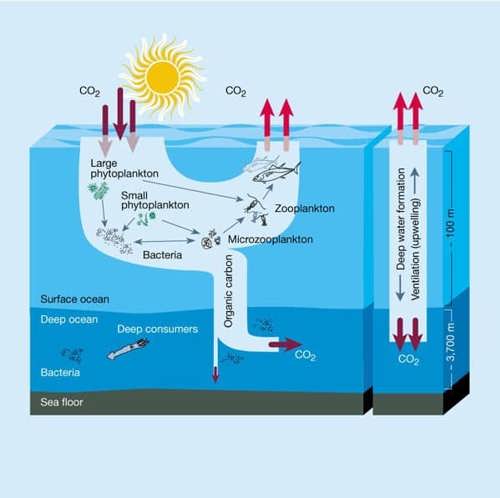The documentary makes some truly shocking claims:
- 50 million sharks a year are killed as a result of bycatch (the capture of non-target species such as dolphins, sharks, turtles and even seabirds).
- Only 5% of the world’s oceans are protected areas.
- 46% of the Great Pacific Garbage Patch is made up of fishing nets (the Great Pacific Garbage Patch is a floating accumulation of plastic in the Pacific Ocean that is roughly three times the size of France).
However, arguably the most shocking claim came from Professor Callum Roberts, who stated that the 2010 BP Deepwater Horizon oil spill in the Gulf of Mexico was ultimately beneficial to marine wildlife. This is because fishing was banned due to fears of oil contamination, giving the marine life a respite from fishing. He asserts that the fishing industry in the Gulf of Mexico kills more marine wildlife in one day than the oil spill disaster killed over a period of three months. That simply cannot be sustainable.
Unforeseen consequences
Many people view the Amazon Rainforest as the lungs of the Earth. In reality, it is the ocean that is the lungs, and also the heart, of the Earth. Covering 70% of Earth’s surface, the ocean drives the climate that we live in. Through exchanging heat, water and carbon with the atmosphere, the ocean determines the weather and moderates the atmospheric temperature fluctuations that we experience. The ocean is the world’s biggest carbon sink and is therefore our most important resource in the fight against climate change.
The processes that result in so much carbon dioxide (CO2) being sequestered by the ocean are incredibly complex. Changes in the wind and in the temperature and salinity (the concentration of salt) of ocean water drive the currents that take CO2 from the sea surface and lock it away in the deep ocean. The ‘biological pump’ removes CO2 from the atmosphere when plankton photosynthesise, turning CO2 into carbohydrates, use those carbohydrates to grow, die and then sink to the ocean floor, locking the carbon into seafloor sediments. This physical, chemical and biological system is finely balanced and altering just one component of it will cause drastic changes to the other parts of the system. For this reason, anthropogenic impacts on the ocean need to be much more carefully managed.
Every (other) breath you take
Plankton living in the ocean make up less than 1% of all photosynthetic biomass on Earth but account for 50% of all photosynthesis. That means you can thank oceanic plankton for every other breathe you take – good things come in small packages.
As Seaspiracy briefly touches on, removing just one level of the food chain through overfishing can lead to the loss of several other levels in the food chain. This could ultimately mean losing the plankton that remove the carbon that we emit. The need for responsible management of the natural world is more important than ever, as without the sustainable use of resources we will have to face not only the immediate consequences, but also the unforeseen and more severe consequences too.

The ‘Biological Pump’ LEFT: Marine phytoplankton photosynthesise, removing carbon dioxide from the atmosphere, grow and then die and sink to the ocean floor, locking away the carbon in the deep ocean and seafloor sediments.
RIGHT: The physical sequestration of carbon dioxide via deep water formation.
Image taken from: Chisholm, S.W., 2000. Stirring times in the Southern Ocean. Nature, 407(6805), pp.685-686.
Parallels with ESG
The issues raised in Seaspiracy have clear parallels in ESG. Questions over the legitimacy of ‘sustainable fisheries’ and concerns about the guarantees from NGOs and their sustainability labels (claims which have since been denied), mirror similar questions asked of investment managers over fears of greenwashing. Investment managers who are labelling their financial products as environmentally beneficial without having any data to back up those claims are at risk of greenwashing, and all of the associated reputational and financial damage that brings. The only way to avoid such allegations of greenwashing, misselling or mislabelling, is to back up any claims that have been made through rigorous (ESG) data collection, verification and reporting.
People are not only increasingly conscious of where their food is sourced from but also where their money is going. Just as the appetite for (truly) sustainable food is growing, so is the appetite for sustainable investing. The market has moved on from the view that ESG investments may result in positive environmental or social outcomes but diminished returns. In many cases, fully-integrated ESG investment strategies experience higher than average returns. This makes intuitive sense as a good ESG strategy will mitigate risk and increase the longevity of investments through more sustainable business practices. As a result investors, seeking higher risk-adjusted returns, are now turning towards ESG investments. The approach to how we manage our marine resources should be similar, as the current short-term mind-set will ultimately lead to significantly depleted fish stocks in the not-so-distant future.
Riding the wave of change
The maker of Seaspiracy, Ali Tabrizi, finishes the documentary with the notion that the only solution to the current crisis in our oceans is to globally stop eating fish altogether. This is clearly not a feasible or practical solution for the people and economies of countries that heavily rely on fishing. Instead, we need to implement more rigorous policies and better-policed regulations.
Just like the EU Sustainable Finance Disclosure Regulation has been introduced to improve the transparency of non-financial disclosures and to stamp out greenwashing, new and improved legislation for fishing practices is urgently needed to mitigate the anthropogenic damage being caused to the ocean. Examples include:
- Increasing the coverage of protected ocean areas;
- Improving and increasing the policing of illegal fishing (notwithstanding the difficulties);
- Introducing more severe sanctions for discarding (returning unwanted catches to the sea, often dying or dead);
- Innovating catching practices to decrease the amount of bycatch.
The good news is that marine life is incredibly resilient and can quickly bounce back from the brink. In order to enable that to happen, a global concerted effort is needed to massively reduce our impact on what is the lifeblood of our planet: the ocean.
How we can help
Our ESG Ratings and Advisory service helps investors unlock real value and drive transformational change by offering a high quality, global, independent, end-to-end service for the private markets. By deploying intelligent ESG data and insights we aim to drive capital towards ESG performance while influencing significant behavioural change.
Contact us today to find out more.





